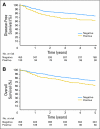Occult metastases in lymph nodes predict survival in resectable non-small-cell lung cancer: report of the ACOSOG Z0040 trial
- PMID: 21990404
- PMCID: PMC3221530
- DOI: 10.1200/JCO.2011.35.2500
Occult metastases in lymph nodes predict survival in resectable non-small-cell lung cancer: report of the ACOSOG Z0040 trial
Abstract
Purpose: The survival of patients with non-small-cell lung cancer (NSCLC), even when resectable, remains poor. Several small studies suggest that occult metastases (OMs) in pleura, bone marrow (BM), or lymph nodes (LNs) are present in early-stage NSCLC and are associated with a poor outcome. We investigated the prevalence of OMs in resectable NSCLC and their relationship with survival.
Patients and methods: Eligible patients had previously untreated, potentially resectable NSCLC. Saline lavage of the pleural space, performed before and after pulmonary resection, was examined cytologically. Rib BM and all histologically negative LNs (N0) were examined for OM, diagnosed by cytokeratin immunohistochemistry (IHC). Survival probabilities were estimated using the Kaplan-Meier method. The log-rank test and Cox proportional hazards regression model were used to compare survival of groups of patients. P < .05 was considered significant.
Results: From July 1999 to March 2004, 1,047 eligible patients (538 men and 509 women; median age, 67.2 years) were entered onto the study, of whom 50% had adenocarcinoma and 66% had stage I NSCLC. Pleural lavage was cytologically positive in only 29 patients. OMs were identified in 66 (8.0%) of 821 BM specimens and 130 (22.4%) of 580 LN specimens. In univariate and multivariable analyses OMs in LN but not BM were associated with significantly worse disease-free survival (hazard ratio [HR], 1.50; P = .031) and overall survival (HR, 1.58; P = .009).
Conclusion: In early-stage NSCLC, LN OMs detected by IHC identify patients with a worse prognosis. Future clinical trials should test the role of IHC in identifying patients for adjuvant therapy.
Conflict of interest statement
Authors' disclosures of potential conflicts of interest and author contributions are found at the end of this article.
Figures





Comment in
-
Occult nodal metastasis in non-small-cell lung cancer: implications for the radiation oncologist.J Clin Oncol. 2012 Jul 1;30(19):2423. doi: 10.1200/JCO.2011.41.2148. Epub 2012 May 21. J Clin Oncol. 2012. PMID: 22614992 No abstract available.
Similar articles
-
Prognostic value of cytokeratin-positive cells in the bone marrow and lymph nodes of patients with resected nonsmall cell lung cancer: a multicenter prospective study.Ann Thorac Surg. 2003 Jul;76(1):194-201; discussion 202. doi: 10.1016/s0003-4975(03)00130-9. Ann Thorac Surg. 2003. PMID: 12842539
-
Risk factor analysis of locoregional recurrence after sublobar resection in patients with clinical stage IA non-small cell lung cancer.J Thorac Cardiovasc Surg. 2013 Aug;146(2):372-8. doi: 10.1016/j.jtcvs.2013.02.057. J Thorac Cardiovasc Surg. 2013. PMID: 23870323
-
Detection of Occult Micrometastases in Patients With Clinical Stage I Non-Small-Cell Lung Cancer: A Prospective Analysis of Mature Results of CALGB 9761 (Alliance).J Clin Oncol. 2016 May 1;34(13):1484-91. doi: 10.1200/JCO.2015.63.4543. Epub 2016 Feb 29. J Clin Oncol. 2016. PMID: 26926677 Free PMC article.
-
Do bone marrow isolated tumor cells influence long-term survival of non-small cell lung cancer?Eur J Cardiothorac Surg. 2009 Mar;35(3):463-8. doi: 10.1016/j.ejcts.2008.11.017. Epub 2009 Jan 15. Eur J Cardiothorac Surg. 2009. PMID: 19150243
-
Prognostic significance of micrometastasis in non-small-cell lung cancer.Clin Lung Cancer. 2004 Jan;5(4):214-25. doi: 10.3816/CLC.2004.n.002. Clin Lung Cancer. 2004. PMID: 14967073 Review.
Cited by
-
Current innovations in sentinel lymph node mapping for the staging and treatment of resectable lung cancer.Semin Thorac Cardiovasc Surg. 2014 Autumn;26(3):201-9. doi: 10.1053/j.semtcvs.2014.09.001. Epub 2014 Sep 16. Semin Thorac Cardiovasc Surg. 2014. PMID: 25527014 Free PMC article. Review.
-
Lung cancer lymph node micrometastasis detection using real-time polymerase chain reaction: correlation with vascular endothelial growth factor expression.J Thorac Cardiovasc Surg. 2013 Mar;145(3):702-7; discussion 707-8. doi: 10.1016/j.jtcvs.2012.12.023. J Thorac Cardiovasc Surg. 2013. PMID: 23414988 Free PMC article.
-
Incidence and clinical relevance of non-small cell lung cancer lymph node micro-metastasis detected by staging endobronchial ultrasound-guided transbronchial needle aspiration.J Thorac Dis. 2019 Aug;11(8):3650-3658. doi: 10.21037/jtd.2019.05.36. J Thorac Dis. 2019. PMID: 31559073 Free PMC article.
-
Prognosis of nodal micrometastasis in resectable pN0 non-small cell lung cancer.Front Oncol. 2025 Jan 31;15:1424682. doi: 10.3389/fonc.2025.1424682. eCollection 2025. Front Oncol. 2025. PMID: 39959671 Free PMC article.
-
Myeloid clusters are associated with a pro-metastatic environment and poor prognosis in smoking-related early stage non-small cell lung cancer.PLoS One. 2013 May 24;8(5):e65121. doi: 10.1371/journal.pone.0065121. Print 2013. PLoS One. 2013. PMID: 23717691 Free PMC article.
References
-
- Jemal A, Siegel R, Ward E, et al. Cancer statistics, 2009. CA Cancer J Clin. 2009;59:225–249. - PubMed
-
- Goldstraw P, Crowley J, Chansky K, et al. The IASLC Lung Cancer Staging Project: Proposals for the revision of the TNM stage groupings in the forthcoming (seventh) edition of the TNM classification of malignant tumours. J Thorac Oncol. 2007;2:706–714. - PubMed
-
- Decker RH, Wilson LD. Postoperative radiation therapy for non-small cell lung cancer. Semin Thorac Cardiovasc Surg. 2008;20:184–187. - PubMed
-
- Wakelee H, Chhatwani L. Adjuvant chemotherapy for resected non-small cell lung cancer. Semin Thorac Cardiovasc Surg. 2008;20:198–203. - PubMed
-
- Price KAR, Azzoli CG, Gaspar LE. Chemoradiation for unresectable stage III non-small cell lung cancer. Semin Thorac Cardiovasc Surg. 2008;20:204–209. - PubMed
Publication types
MeSH terms
Grants and funding
LinkOut - more resources
Full Text Sources
Other Literature Sources
Medical

